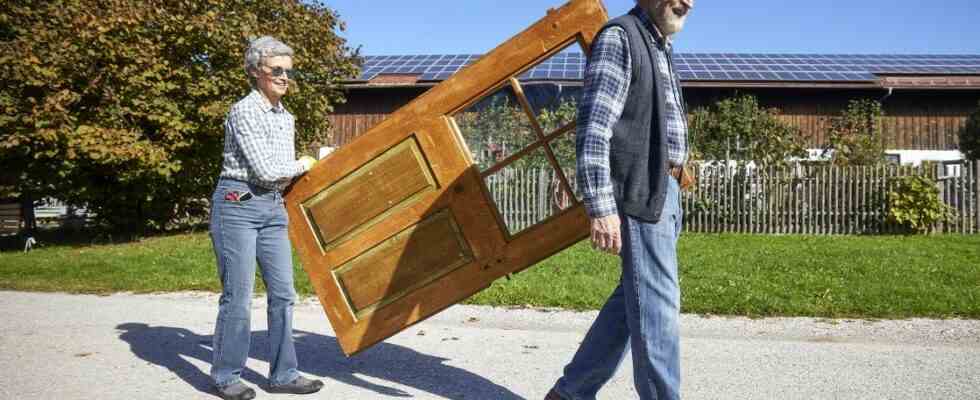Doors – they protect and close. They can also be decorative, even representative design elements. Doors are the passage that separates the private from the public. They symbolize everyday life and yet they are a building’s calling card. Whether apartment door, front door or revolving door: Everyone uses them without often paying much attention to them. They also have a story. One person who wants to preserve this history is Johannes Bauer from Penzberg. He collects historical doors – simply because they are beautiful in their own way.
Collectors, social scientists and psychologists say, enjoy greater life satisfaction and rarely suffer from depression. But sometimes the cause of a hobby can be much simpler. Johannes Bauer initially had very pragmatic reasons for collecting doors. When he moved back to his parents’ farm from Munich with his family, his wife Cornelia Graßl-Bauer had a wish. In the course of the renovation of the farm in Nantesbuch near Penzberg, old doors were to be installed again, just those that match the historic building. The first “Paur” came to the farm in 1695.
Johannes Bauer and his wife Cornelia wanted to create a home there. That was in 1984. The Bauers were lucky and found the original front door in the attic. The interiors should also be upgraded with matching passageways. “I drove to the neighbors,” says the 73-year-old. He rattled around the courtyards and found what he was looking for. For example in the chicken coop. Some neighbors then said: “If so, then take everyone with you.” Johannes Bauer didn’t need to be asked twice. The start was made – at a time when the term “upcycling” was not on everyone’s lips.
Still life with quinces: the collector’s items look particularly good in the Bauer family’s orchard.
(Photo: farmer/oh)
The doors in the warehouse are neatly numbered and cataloged as befits a proper collection. There is documentation for each one that provides information about its origin. Cornelia Graßl-Bauer, who chaired the local Green Party for many years, is completely with her husband. The 67-year-old uses the sunny autumn day to replace the stickers with the numbers on the doors. The Bauers have brought some of the most beautiful specimens into the open. After all, the sweethearts should be put in the right light. They are particularly photogenic in the orchard. Johannes Bauer points to a door because the fittings are as beautiful as he thinks. An important detail, as well as the locking mechanism. “You have to see if it’s a clever lock,” he says. It is not a problem for him to repair or even replace locks and fittings. The culture award winner and former deputy mayor of the city of Penzberg has collected a box with old locks. He has acquired the necessary manual skills over the years.
In the Zisthof, a wide variety of wooden doors adorn the rooms. Some are painted, as is known from peasant cupboards, with roses and Madonna. Pious blessings should not be missing. Some are simple, without any frame, but no less beautiful. The pool of 50 doors also benefited his daughter. When she moved into her parents’ house with her husband and children, it was remodeled and expanded again. Ten doors were needed. “She could just say: they, they, and they.” Father Johannes worked on the doors and installed them. Because the dimensions do not always correspond to modern habits and comfort. “Then it has to be pieced together.” The stop must also fit, i.e. in which direction the doors can be opened.
The neoclassical door (left) comes from a farm in Beuerberg; the bright door (right) from the former Berggeist inn in Penzberg.
(Photo: Manfred Neubauer)
Leaning against the shed is a neoclassical door, a particularly pretty example, for viewing. The 73-year-old got this front door from a farmer from Beuerberg in the neighboring district of Bad Tölz-Wolfratshausen. Another door lights up the blue autumn sky with colorful Lüftlmalerei. A door with a hatch is plain in cream, but no less decorative. It comes from the former Gasthof Berggeist in Penzberg.
Johannes Bauer does the carpentry work on the house and farm himself. He has his own workshop. “There was always a craft being practiced on farms,” he says. The carpentry belongs to the Zisthof. Johannes Bauer was only 16 years old when his father died. Luckily he had an uncle who taught him how to work with wood. Not without pride he leads to the wooden staircase in the house. The curved railing is made of one piece. “I’ve been beautifying the yard for almost 60 years.” So it is no coincidence that wood is not in short supply at the Zisthof. If a tree needs to be felled, Bauer has boards cut from the trunk. He pricks up his ears when tribes attack in the neighborhood. Like a walnut tree, for example, which he immediately secured. After all, who knows what project will not soon need the right material. The next step is to build a staircase again.
Detail of the original Zisthof front door. The Bauers found them in the attic while renovating the house.
(Photo: Manfred Neubauer)
Doors with history – they exist. Almost everyone knows the front door of No. Downing Street. 10 in London. Or that door of the Reformation: Martin Luther posted his theses on the Castle Church in Wittenberg. When humans settled down about 12,000 years ago, they needed permanent dwellings that offered protection from the weather and enemies. The birth of the door, so to speak. Gates and doors have always been important in people’s lives. Johannes Bauer likes to talk about “value” when presenting his collector’s items. “I don’t have to do anything with them,” he says, “they simply have a good place with us.”

